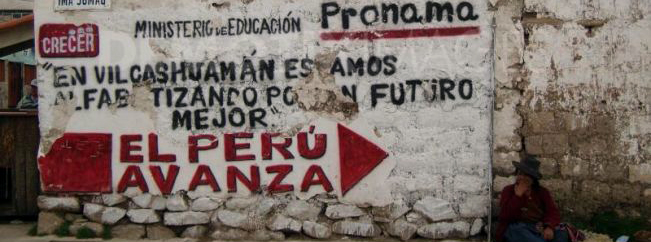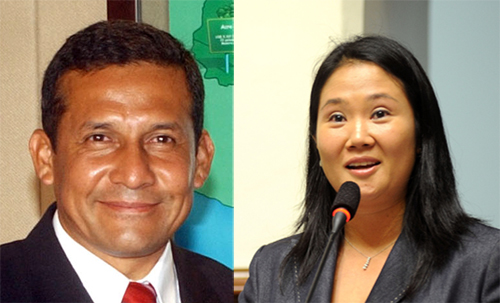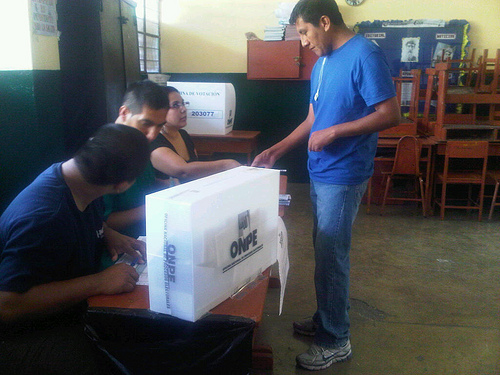
Caution, Left Turn Only: Peruvian Elections
22 April, 2011I once heard a Sociologist at UC Berkeley say that the left is always the right way. Latin America seems to be taking this seriously. The tendency to go left has become obvious in the choices the Latin American people have been making.
More than a decade ago, in 1998, the Venezuelan people chose Hugo Chavez as their president. In 2005, Evo Morales was elected President of Bolivia. He was re-elected in 2009 with over 63% of the votes. In Ecuador, a strong critic of neo-liberal policies and former Economic Minister, Rafael Correa was elected in 2006. This year, Dilma Roussef, a former militant and Marxist representing the Worker’s Party succeed Luiz Inacio Lula da Silva and became the first female Brazilian President. Peru may not be the exception.
But the Peruvian case is a special and scary one. On April 10th, the Peruvian presidential elections were held. Ollanta Humala, a former military officer representing the nationalist party, got 31.7% of the population’s votes followed by Keiko Fujimori, who got 23.5%. Because neither got more than 50% of the votes, Humala and Fujimori will face each other in a run-off in early June. Humala has been strongly criticised for his relations with Chávez and his “radical” tendencies. With a government plan called The Great Transformation, resembling Karl Polanyi’s master work by more than just it’s title, Humala is convinced that, in spite of the country’s economic growth and rising GDP, the distribution of wealth in Peru is far from being equal. Fujimori, on the other side, causes panic in the population because she is the daughter of Alberto Fujimori, who is currently serving a 25-year sentence for human right violations and considered one of the most corrupt leaders in world history.

Last week, a former US ambassador and a professor of International Affairs at a recognized US university published an article talking about Latin America’s self-destructive tendencies and Peru’s political suicide. Is it surprising that Peru has gotten to this point, in which a former military colonel with so-called radical tendencies and the daughter of a human rights violator may become the next President of Peru and take her father and his corrupt entourage out of prison? For the upper classes and outsiders yes, this sounds ridiculous, considering the number of candidates Peruvians had to chose from, including former President and Economist Alejandro Toledo, who holds a PhD from Stanford University, Pedro Pablo Kuczynski, former Minister of Economy and Finance of Peru, among others. Then why? Why if there was a variety of stable and experiences candidates did the people chose the most controversial ones? The message is clear: Peruvians are screaming for change.
El Perú, Avanza?
In the midst of big signs with the words El Perú Avanza, “Peru is Going Forward”, printed on them, over 30% of the population live under the poverty line. Extreme poverty reaches almost 10%, and while the city of Lima is constantly growing and getting world attention for their high-end restaurants and economic growth, the rest of the country, including the slums or pueblo jóvenes in Lima, remain in poverty. Inequality is everywhere: from kids selling candy on congested avenues in the capital, workers protesting in the mining zones high up in the Andes, peasants getting exploited and selling their crops for almost nothing. These people would laugh in your face if you told them “your country is growing.” There is an evident class struggle yet the privileged elites in Lima still do not understand why 31% of the population would vote for Humala, considering the current economic model is working oh-so well for Peru.

But why Fujimori? Her father Alberto Fujimori was the founder of Fujimorismo. This means, his strategies cannot really be associated with any other president. He was a populist, a man who committed several atrocities but knew how to act very well. Under his regime, the Maoist guerrillas called the Shining Path was eradicated, highways and schools were built in towns where the presence of the state had never been felt before. Not only did he eradicate terrorism but with shoes, popular programs and blankets he kept some poor people happy. That was enough to buy their vote and make them faithful forever. However, if you look at the map that shows who voted for whom in the elections, you will see that during the times of the Shining Path, the zones that were affected the most voted mainly for Humala. This is because the Peruvian Army killed more than half of the estimated 70,000 victims during the internal conflict. Furthermore, Fujimori, through a family planning program, forced the sterilization of Peru’s poor women. Several women died following sterilization procedures and thousands remain traumatized or have suffered complications due to the procedures.
What is scary is that the upper classes, since their candidates did not make it to the run-off, may vote for Keiko Fujimori. Their main argument is that Humala represents a risk to the current neo-liberal economic model, which they seem to praise. Leaving human right violations and their memory on the side, they prefer a President who will guarantee that their pockets continue to be full. Keiko Fujimori holds an MBA from Columbia University, and she promises to “manage the Peruvian economy responsibly.” But the question is what does responsible mean?
Responsible, for many, might translate into unequal. Regardless of the outcome, the Peruvian people will chose their next President democratically. However, if Humala becomes the next President, it will prove what other Latin Americans have proven: the left does not have to be the scary, communist way, it can be a step closer to democracy. Anti cold-war feelings remain strong in Latin American elites. Pinochet supporters in Chile tend to attribute Chilean economic growth to the former dictator. Some Fujimoristas also attribute Peruvian current growth to his 1990’s regime. The terms communist, radical, leftist and terrorist are usually put in the same bag. For many, there are no clear distinctions among them. This is changing. For a country that experienced their bloodiest époque during the times of the Shining Path, it is understandable that many may be afraid of a leftist candidate. Chávez radical mandate should not be considered the only example of the left. Luiz Inacio Lula da Silva, for example, has shown the world that radical measures are not necessary to create progressive change. Whatever happens, the Peruvian people should remember that history repeats itself first as tragedy, then as farce. For now, until the run-off, let’s hope for the best.
The second round of voting will be held on June 5th 2011.
Follow Sounds and Colours: Facebook / Twitter / Instagram / Mixcloud / Soundcloud / Bandcamp
Subscribe to the Sounds and Colours Newsletter for regular updates, news and competitions bringing the best of Latin American culture direct to your Inbox.

